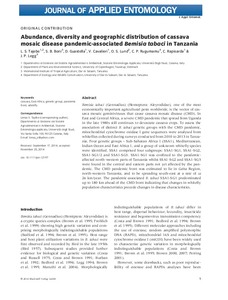| dc.contributor.author | Tajebe, L. |
| dc.contributor.author | Boni, S.B. |
| dc.contributor.author | Guastella, D. |
| dc.contributor.author | Cavalieri, V. |
| dc.contributor.author | Lund, O. |
| dc.contributor.author | Rugumamu, C.P. |
| dc.contributor.author | Rapisarda, C. |
| dc.contributor.author | Legg, J.P. |
| dc.date.accessioned | 2019-12-04T11:03:36Z |
| dc.date.available | 2019-12-04T11:03:36Z |
| dc.date.issued | 2015-09-15 |
| dc.identifier.citation | Tajebe, L.S., Boni, S.B., Guastella, D., Cavalieri, V., Lund, O.S., Rugumamu, C.P., ... & Legg, J.P. (2015). Abundance, diversity and geographic distribution of cassava mosaic disease pandemic‐associated Bemisia tabaci in Tanzania. Journal of Applied Entomology, 139(8), 627-637. |
| dc.identifier.issn | 0931-2048 |
| dc.identifier.uri | https://hdl.handle.net/20.500.12478/1159 |
| dc.description | Published online: 26 Dec 2014 |
| dc.description.abstract | Bemisia tabaci (Gennadius) (Homoptera: Aleyrodidae), one of the most economically important agricultural pests worldwide, is the vector of cassava mosaic geminiviruses that cause cassava mosaic disease (CMD). In East and Central Africa, a severe CMD pandemic that spread from Uganda in the late 1980s still continues to devastate cassava crops. To assess the association of distinct B. tabaci genetic groups with the CMD pandemic, mitochondrial cytochrome oxidase I gene sequences were analysed from whiteflies collected during surveys conducted from 2010 to 2013 in Tanzania. Four genetic groups – Sub-Saharan Africa 1 (SSA1), Mediterranean, Indian Ocean and East Africa 1, and a group of unknown whitefly species were identified. SSA1 comprised four subgroups: SSA1-SG1, SSA1-SG2, SSA1-SG1/2 and SSA1-SG3. SSA1-SG1 was confined to the pandemic-affected north-western parts of Tanzania whilst SSA1-SG2 and SSA1-SG3 were found in the central and eastern parts not yet affected by the pandemic. The CMD pandemic front was estimated to lie in Geita Region, north-western Tanzania, and to be spreading south-east at a rate of ca 26 km/year. The pandemic-associated B. tabaci SSA1-SG1 predominated up to 180 km ahead of the CMD front indicating that changes in whitefly population characteristics precede changes in disease characteristics. |
| dc.format.extent | 627-637 |
| dc.language.iso | en |
| dc.subject | Cassava |
| dc.subject | Bemisia Tabaci |
| dc.subject | Aleyrodidae |
| dc.subject | Whiteflies |
| dc.title | Abundance, diversity and geographic distribution of cassava mosaic disease pandemic-associated Bemisia tabaci in Tanzania |
| dc.type | Journal Article |
| dc.description.version | Peer Review |
| cg.contributor.crp | Roots, Tubers and Bananas |
| cg.contributor.affiliation | Università degli Studi |
| cg.contributor.affiliation | University of Copenhagen |
| cg.contributor.affiliation | International Institute of Tropical Agriculture |
| cg.contributor.affiliation | University of Dar es Salaam |
| cg.coverage.region | Africa |
| cg.coverage.region | East Africa |
| cg.coverage.country | Tanzania |
| cg.coverage.country | Uganda |
| cg.isijournal | ISI Journal |
| cg.authorship.types | CGIAR and developing country institute |
| cg.authorship.types | CGIAR and advanced research institute |
| cg.iitasubject | Cassava |
| cg.iitasubject | Plant Diseases |
| cg.journal | Journal of Applied Entomology |
| cg.howpublished | Formally Published |
| cg.accessibilitystatus | Limited Access |
| local.dspaceid | 78234 |
| cg.targetaudience | Scientists |
| cg.identifier.doi | https://dx.doi.org/10.1111/jen.12197 |

